Troy-Bilt TB22 EC User Manual
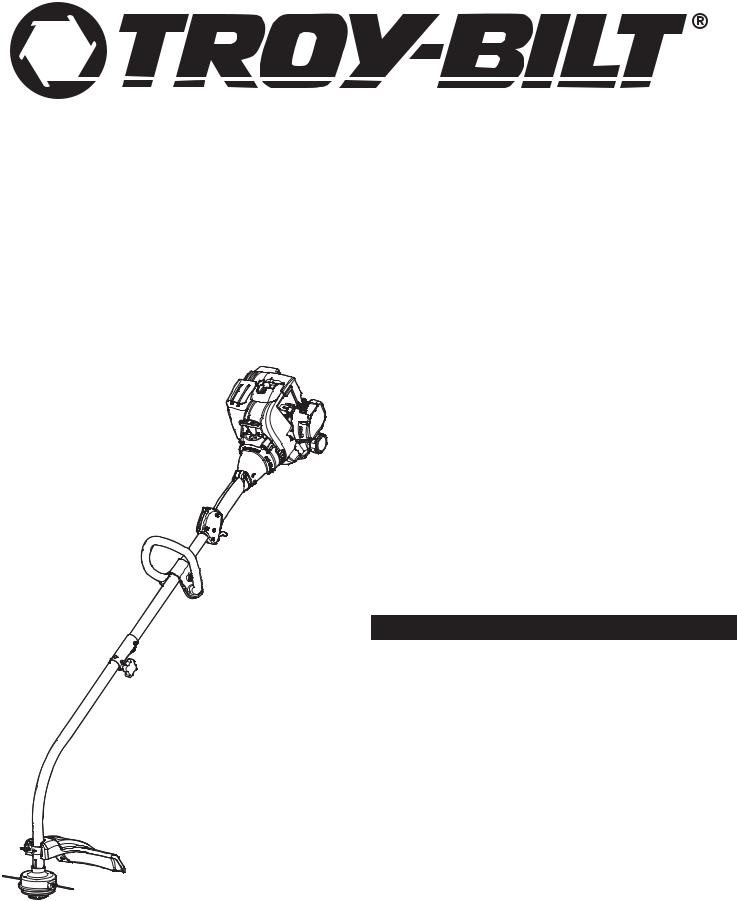
Operator’s Manual
Electric Start Capable
2-Cycle Trimmer
TB22 EC
TABLE OF CONTENTS
Service . . . . . . . . . . . . . . . . . . . . . . . . . . . . . . . . . . . . . . . . . . . . . . .1
Safety . . . . . . . . . . . . . . . . . . . . . . . . . . . . . . . . . . . . . . . . . . . . . . .2
Know Your Unit . . . . . . . . . . . . . . . . . . . . . . . . . . . . . . . . . . . . . . . .5
Specifications . . . . . . . . . . . . . . . . . . . . . . . . . . . . . . . . . . . . . . . . .5
Assembly . . . . . . . . . . . . . . . . . . . . . . . . . . . . . . . . . . . . . . . . . . . . .6
Oil and Fuel . . . . . . . . . . . . . . . . . . . . . . . . . . . . . . . . . . . . . . . . . . .8
Starting and Stopping . . . . . . . . . . . . . . . . . . . . . . . . . . . . . . . . . . .9
Operation . . . . . . . . . . . . . . . . . . . . . . . . . . . . . . . . . . . . . . . . . . . .11
Maintenance . . . . . . . . . . . . . . . . . . . . . . . . . . . . . . . . . . . . . . . . .13
Cleaning and Storage . . . . . . . . . . . . . . . . . . . . . . . . . . . . . . . . . .17
Troubleshooting . . . . . . . . . . . . . . . . . . . . . . . . . . . . . . . . . . . . . . .18
Warranty . . . . . . . . . . . . . . . . . . . . . . . . . . . . . . . . . . . . . . . . . . . .20
SAVE THESE INSTRUCTIONS
SERVICE
DO NOT RETURN THIS UNIT TO THE RETAILER. PROOF OF PURCHASE WILL BE REQUIRED FOR WARRANTY SERVICE.
For assistance regarding the assembly, controls, operation or maintenance of the unit, please call the Customer Support Department at 1-800-828-5500 in the United States or 1-800-668-1238 in Canada. Additional information about the unit can be found on our website: www.troybilt.com (U.S.) or www.troybilt.ca (Canada).
For service, please call the Customer Support Department to obtain a list of authorized service dealers near you. Service on this unit, both within and after the warranty period, should only be performed by an authorized and approved service dealer. When servicing, use only identical replacement parts.
All information, illustrations, and specifications in this manual are based on the latest product information available at the time of printing. We reserve the right to make changes at any time without notice.
Copyright© 2014 MTD SOUTHWEST INC, All Rights Reserved.
IMPORTANT: Read this manual thoroughly before using this product. Follow all instructions.
769-10064 / 00 |
07/14 |
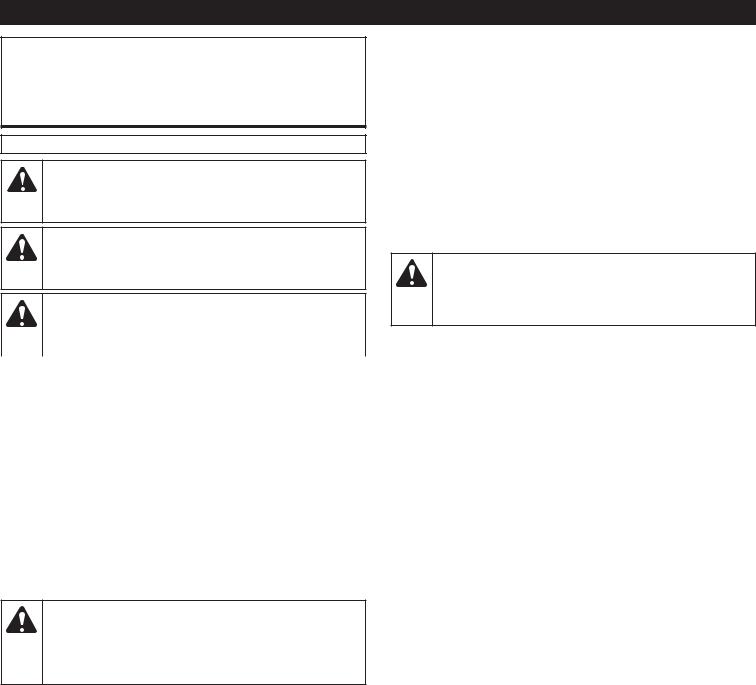
SAFETY
The purpose of safety symbols is to attract your attention to possible dangers. The safety symbols, and their explanations, deserve your careful attention and understanding. The safety warnings do not by themselves eliminate any danger. The instructions or warnings they give are not substitutes for proper accident prevention measures.
SYMBOL MEANING
DANGER: Signals an EXTREME hazard.
Failure to obey a safety DANGER signal WILL result in serious injury or death to yourself or to others.
WARNING: Signals a SERIOUS hazard.
Failure to obey a safety WARNING signal CAN result in serious injury to yourself or to others.
CAUTION: Signals a MODERATE hazard.
Failure to obey a safety CAUTION signal MAY result in property damage or injury to yourself or to others.
NOTE: Advises you of information or instructions vital to the operation or maintenance of the equipment.
SPARK ARRESTOR NOTE
NOTE: For users on U.S. Forest Land and in the states of California, Maine, Oregon and Washington. All U.S. Forest Land and the state of California (Public Resources Codes 4442 and 4443), Oregon and Washington require, by law that certain internal combustion engines operated on forest brush and/or grass-covered areas be equipped with a spark arrestor, maintained in effective working order, or the engine be constructed, equipped and maintained for the prevention of fire. Check with your state or local authorities for regulations pertaining to these requirements. Failure to follow these requirements could subject you to liability or a fine.
This unit is factory equipped with a spark arrestor. If it requires replacement, contact your local service dealer to install the appropriate muffler assembly.
CALIFORNIA PROPOSITION 65
WARNING:This product contains a chemical known to the state of California to cause cancer, birth defects or other reproductive harm.
Read the operator’s manual and follow all warnings and safety instructions. Failure to do so can result in serious injury to the operator and/or bystanders.
• IMPORTANT SAFETY INSTRUCTIONS •
READ ALL INSTRUCTIONS BEFORE OPERATING
WARNING: When using the unit, all safety instructions must be followed. Please read these instructions before operating the unit in order to ensure the safety of the operator and any bystanders. Please keep these instructions for later use.
•Read the instructions carefully. Be familiar with the controls and proper use of the unit.
•Do not operate this unit when tired, ill or under the influence of alcohol, drugs or medication.
•Children must not operate the unit. Teens must be accompanied and guided by an adult.
•All guards and safety attachments must be installed properly before operating the unit.
•Inspect the unit before use. Replace damaged parts. Check for fuel leaks. Make sure all fasteners are in place and secure. Replace parts that are cracked, chipped, or damaged in any way. Do not operate the unit with loose or damaged parts.
•Only use the trimming line described in the Specifications section of this manual. Never use metal-reinforced line, wire, chain or rope. These can break off and become dangerous projectiles.
•Do not replace the cutting head with rigid or metal blades. Doing so could result in serious injury.
•Be aware of risk of injury to the head, hands and feet.
•Carefully inspect the area before starting the unit. Remove rocks, broken glass, nails, wire, string and other objects that may be thrown or become entangled with the unit.
•Clear the area of children, bystanders and pets; keep them outside a 50-foot (15 m) radius, at a minimum. Even then, they are still at risk from thrown objects. Encourage bystanders to wear eye protection. If you are approached, stop the unit immediately.
•Squeeze the throttle control and check that it returns automatically to the idle position. Make all adjustments or repairs before using the unit.
•This unit is intended for occasional, household use only.
2

SAFETY WARNINGS FOR GAS UNITS


 WARNING:Gasoline is highly flammable and its vapors can explode if ignited. Take the following precautions:
WARNING:Gasoline is highly flammable and its vapors can explode if ignited. Take the following precautions:
•Store fuel only in containers specifically designed and approved for the storage of such materials.
•Always stop the engine and allow it to cool before filling the tank. Never remove the fuel tank cap or add fuel when the engine is hot. Always loosen the fuel tank cap slowly to relieve any pressure in the tank before fueling.
•Always mix and add fuel in a clean, well-ventilated outdoor area where there are no sparks or flames. DO NOT smoke.
•Never operate the unit without the fuel cap securely in place.
•Avoid creating a source of ignition for spilled fuel. Wipe up any spilled fuel from the unit immediately, before starting the unit. Move the unit at least 30 ft. (9.1 m) from the fueling source and site before starting the engine. DO NOT smoke.
•Never start or run the unit inside a closed room or building. Breathing exhaust fumes can kill. Operate this unit only in a well ventilated outdoor area.
WHILE OPERATING
•Wear safety glasses or goggles that meet current ANSI / ISEA Z87.1 standards and are marked as such. Wear ear/hearing protection when operating this unit. Wear a face mask or dust mask if the operation is dusty.
•Wear heavy long pants, boots, gloves and a long sleeve shirt. Do not wear loose clothing, jewelry, short pants, sandals or go barefoot. Secure hair above shoulder level.
•The cutting head shield must always be in place while operating the unit. Do not operate the unit without both trimming lines extended and the proper line installed. Do not extend the trimming line beyond the length of the shield.
•This unit has a clutch. The cutting head remains stationary when the engine is idling. If it does not, take the unit to an authorized service dealer for an adjustment.
•Adjust the handle to provide the best grip, if applicable.
•Make sure the attachment is not in contact with anything before starting the unit.
•Use the unit only in daylight or good artificial light.
•Avoid accidental starting. Be in the starting position whenever pulling the starter rope. The operator and unit must be in a stable position while starting. Refer to Starting and Stopping.
•Use the right tool. Only use this tool for its intended purpose.
•Always hold the unit with both hands when operating. Keep a firm grip on both handles or grips.
•Do not overreach. Always keep proper footing and balance. Take extra care when working on stairs, steep slopes or inclines. To avoid serious injury, do not operate the unit while on a ladder or a roof.
•Keep hands, face, and feet away from all moving parts. Do not touch or try to stop moving parts.
•Do not touch the engine, gear housing or muffler. These parts get extremely hot from operation, even after the unit is turned off.
•Do not operate the unit faster than the speed needed to do the job. Do not run the unit at high speed when not in use.
•Do not force the unit. It will do a better, safer job when used at the intended rate.
•Always stop the unit when operation is delayed or when walking from one location to another.
•If you strike or become entangled with a foreign object, stop the unit immediately and check for damage. Do not operate the unit before repairing damage. Do not operate the unit with loose or damaged parts.
•Turn the engine to off and disconnect the spark plug for maintenance or repair.
•Use only original equipment manufacturer (OEM) replacement parts and accessories for this unit. These are available from your authorized service dealer. Use of any other parts or accessories could lead to serious injury to the user, or damage to the unit, and void the warranty.
•Keep the unit clean. Carefully remove vegetation and other debris that could block moving parts.
•To reduce fire hazard, replace a faulty muffler and spark arrestor. Keep the engine and muffler free from grass, leaves, excessive grease or carbon build up.
•If the unit starts to vibrate abnormally, stop the unit immediately. Inspect the unit for the cause of the vibration. Vibration is generally an indicator of trouble.
OTHER SAFETY WARNINGS
•Maintain the unit with care.
•All service, other than the maintenance procedures described in this manual, should be performed by an authorized service dealer.
•Never remove, modify or make inoperative any safety device furnished with the unit.
•Before inspecting, servicing, cleaning, storing, transporting or replacing any parts on the unit:
1.Stop the unit.
2.Make sure all moving parts have stopped.
3.Allow the unit to cool.
4.Disconnect the spark plug wire.
•Secure the unit while transporting.
•Never store the unit with fuel in the tank, inside a building where fumes may reach an open flame (pilot lights, etc.) or sparks (switches, electrical motors, etc.).
•Store the unit in a dry place, secured or at a height to prevent unauthorized use or damage. Keep the unit out of the reach of children.
•Never douse or squirt the unit with water or any other liquid. Keep handles dry and clean (free from debris, oil and grease). Clean the unit after each use. Refer to Cleaning and Storage. Do not use solvents or strong detergents.
•Keep these instructions. Refer to them often and use them to instruct other users. If you loan this unit to others, also loan them these instructions.
SAVE THESE INSTRUCTIONS
3
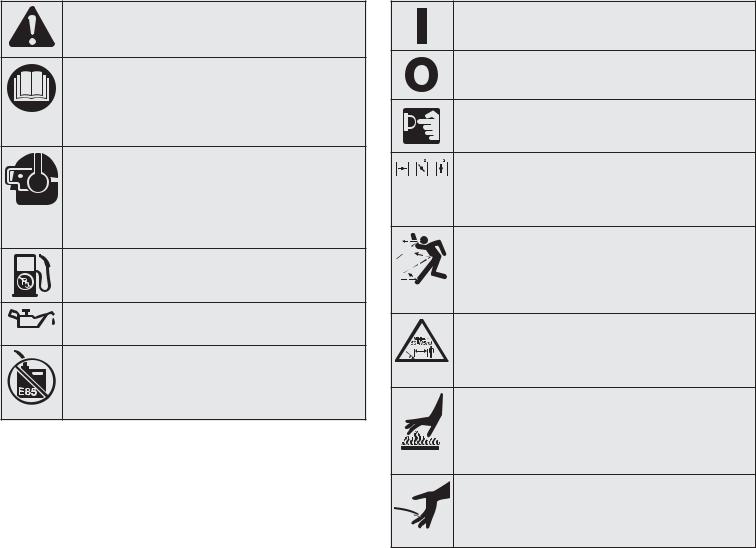
• SAFETY & INTERNATIONAL SYMBOLS •
This operator's manual describes safety and international symbols and pictographs that may appear on this product. Read the operator's manual for complete safety, assembly, operating and maintenance and repair information.
SYMBOL MEANING
•SAFETY ALERT SYMBOL
Indicates danger, warning or caution. May be used in conjunction with other symbols or pictographs.
•READ OPERATOR'S MANUAL
WARNING: Read the operator’s manual(s) and follow all warnings and safety instructions. Failure to do so can result in serious injury to the operator and/or bystanders.
• WEAR EYE AND HEARING PROTECTION
WARNING: Thrown objects and loud noise can cause severe eye injury and hearing loss. Wear eye protection meeting current ANSI / ISEA Z87.1 standards and ear protection when operating this unit. Use a full face shield when needed.
•UNLEADED FUEL
Always use clean, fresh unleaded fuel.
•OIL
Refer to operator’s manual for the proper type of oil.
•DO NOT USE E85 FUEL IN THIS UNIT
WARNING: It has been proven that fuel containing greater than 10% ethanol will likely damage this engine and void the warranty.
SYMBOL MEANING
•ON/OFF STOP CONTROL
ON / START / RUN
•ON/OFF STOP CONTROL
OFF or STOP
•PRIMER BULB
Push primer bulb, fully and slowly, 10 times.
• CHOKE CONTROL
1.• FULL choke position
2.• PARTIAL choke position
3.• RUN choke position
• THROWN OBJECTS AND ROTATING CUTTER CAN CAUSE SEVERE INJURY
WARNING: Small objects can be propelled at high speed, causing injury. Keep away from the rotating rotor.
• KEEP BYSTANDERS AWAY
WARNING: Keep all bystanders, especially children and pets, at least 50 feet (15 m) from the operating area.
• HOT SURFACE
WARNING: Do not touch a hot muffler or cylinder. You may get burned. These parts get extremely hot from operation. When turned off, they remain hot for a short time.
• SHARP BLADE
WARNING: Sharp blade on trimmer attachment shield. To prevent serious injury, do not touch the line cutting blade.
4
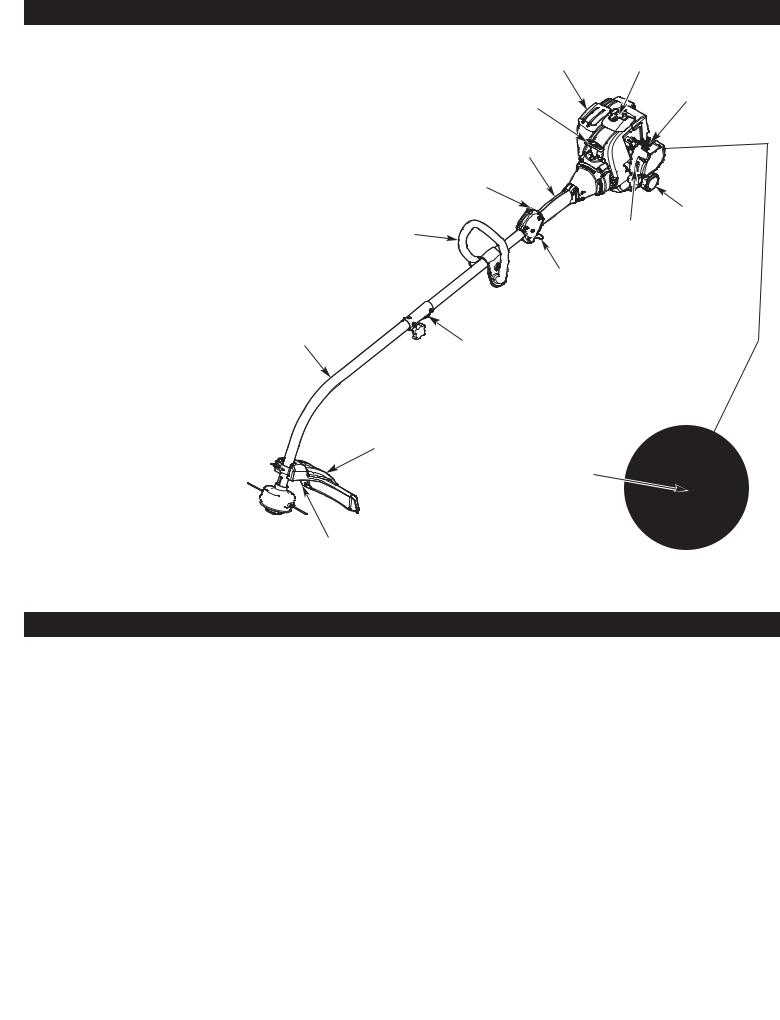
KNOW YOUR UNIT
APPLICATIONS
As a trimmer: |
Muffler |
Spark Plug |
•Cutting grass and light weeds.
• |
Edging |
|
Choke Lever |
• Decorative trimming around trees, fences, etc. |
|
Starter Rope Grip |
|
|
|
||
Other optional accessories may be used with this unit. |
|
|
|
|
|
|
Shaft Grip |
ASSEMBLY TOOLS REQUIRED: |
|
On/Off Switch |
|
• |
3/8” Socket |
|
|
|
|
||
|
|
|
Fuel Cap |
|
|
Handle |
Air Filter |
|
|
Cover |
|
|
|
|
|
|
|
|
Throttle |
|
|
|
Control |
|
Shaft Housing |
|
Coupler |
|
|
|
|
Cutting Head Shield
Primer Bulb
Cutting Head 


Line Cutting Blade
SPECIFICATIONS*
Engine Type. . . . . . . . . . . . . . . . . . . . . . . . . . . . . . . . . . . . . . . . . . . . . . . . . . . . . . . . . . . . . . . . . . . . . . . . . . . . . . . . . . . . . . . . Air-Cooled, 2-Cycle Displacement . . . . . . . . . . . . . . . . . . . . . . . . . . . . . . . . . . . . . . . . . . . . . . . . . . . . . . . . . . . . . . . . . . . . . . . . . . . . . . . . . . . . . . . 25 cc (1.52 cu. in.) Spark Plug Gap . . . . . . . . . . . . . . . . . . . . . . . . . . . . . . . . . . . . . . . . . . . . . . . . . . . . . . . . . . . . . . . . . . . . . . . . . . . . . . . . . . . . 0.025 in. (0.635 mm) Spark Plug . . . . . . . . . . . . . . . . . . . . . . . . . . . . . . . . . . . . . . . . . . . . . . . . . . . . . . . . . . . . . . . . . . . . . . . . . . Champion® RDJ7J or equivalent plug Lubrication. . . . . . . . . . . . . . . . . . . . . . . . . . . . . . . . . . . . . . . . . . . . . . . . . . . . . . . . . . . . . . . . . . . . . . . . . . . . . . . . . . . . . . . . . . . . Fuel/Oil Mixture Fuel/Oil Ratio . . . . . . . . . . . . . . . . . . . . . . . . . . . . . . . . . . . . . . . . . . . . . . . . . . . . . . . . . . . . . . . . . . . . . . . . . . . . . . . . . . . . . . . . . . . . . . . . . . 40:1 Fuel Tank Capacity . . . . . . . . . . . . . . . . . . . . . . . . . . . . . . . . . . . . . . . . . . . . . . . . . . . . . . . . . . . . . . . . . . . . . . . . . . . . . . . . . . . . . . 10 oz. (296 ml) Approximate Unit Weight (No fuel) . . . . . . . . . . . . . . . . . . . . . . . . . . . . . . . . . . . . . . . . . . . . . . . . . . . . . . . . . . . . . . . . . . . . 11 - 12 lbs. (5 - 5.4 kg) Trimmer Mechanism . . . . . . . . . . . . . . . . . . . . . . . . . . . . . . . . . . . . . . . . . . . . . . . . . . . . . . . . . . . . . . . . . . . . . . . . . . . . . . . . . . . . . . . Bump Head Trimming Line . . . . . . . . . . . . . . . . . . . . . . . . . . . . . . . . . . . . . . . . . . . . . . . . . . . . . . . . . . . . . . . . . . . . . . . . . . . . . . . . . . . 0.095 inches (2.41 mm) Cutting Path Diameter . . . . . . . . . . . . . . . . . . . . . . . . . . . . . . . . . . . . . . . . . . . . . . . . . . . . . . . . . . . . . . . . . . . . . . . . . . . . . . . . . . . 17 in. (43.2 cm)
* All specifications are based on the latest product information available at the time of printing. We reserve the right to make changes at any time without notice.
5
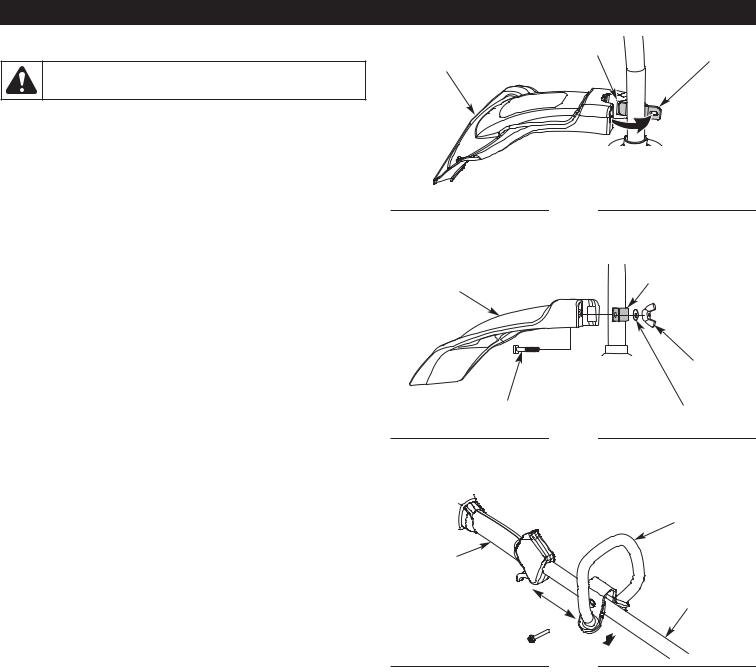
ASSEMBLY
INSTALLING THE CUTTING HEAD SHIELD
WARNING: To prevent serious personal injury, never operate the unit without the cutting head shield in place.
1.Remove the wing nut and washer from the cutting head shield.
2.Insert the short tab (the one without a hole) on the mount bracket into the slot on the cutting head shield (Fig. 1).
3.Rotate the cutting head shield counterclockwise to align the hole on the cutting head shield with the hole on the mount bracket (Fig. 1).
4.Insert the square bolt into the hole underneath the cutting head shield (Fig. 2). Push the square bolt through the cutting head shield and mount bracket.
5.Put the washer onto the square bolt (Fig. 2).
6.Screw the wing nut onto the square bolt until the cutting head shield is firmly in place (Fig. 2).
Cutting Head |
Slot |
|
|
Shield |
|
Fig. 1
Cutting Head
Shield
Square Bolt
Fig. 2
INSTALLING AND ADJUSTING THE HANDLE
Installing the Handle
1.Push the handle down onto the shaft housing (Fig. 3). The bolt hole in the handle should be to the right.
2.Insert the bolt into the bolt hole and push it through (Fig. 3). Tighten the bolt with a 3/8” socket, but do not tighten the bolt completely.
3.While holding the unit in the operating position (Fig. 11), move the handle to the location that provides the best grip. Place it a minimum of 6 inches (15.24 cm) from the end of the shaft grip (Fig. 3).
4.Tighten the bolt with a 3/8” socket until the handle is secure.
Adjusting the Handle
If the handle requires adjustment:
1.Loosen the bolt with a 3/8” socket (Fig. 3).
2.While holding the unit in the operating position (Fig. 11), move the handle to the location that provides the best grip. Place it a minimum of 6 inches (15.24 cm) from the end of the shaft grip (Fig. 3).
3.Tighten the bolt with a 3/8” socket until the handle is secure.
Shaft Grip
Minimum 6 in
(15.24 cm)
Bolt 

Fig. 3
Mount Bracket
Mount Bracket
Wing Nut
Washer
Handle
Shaft
Housing
6
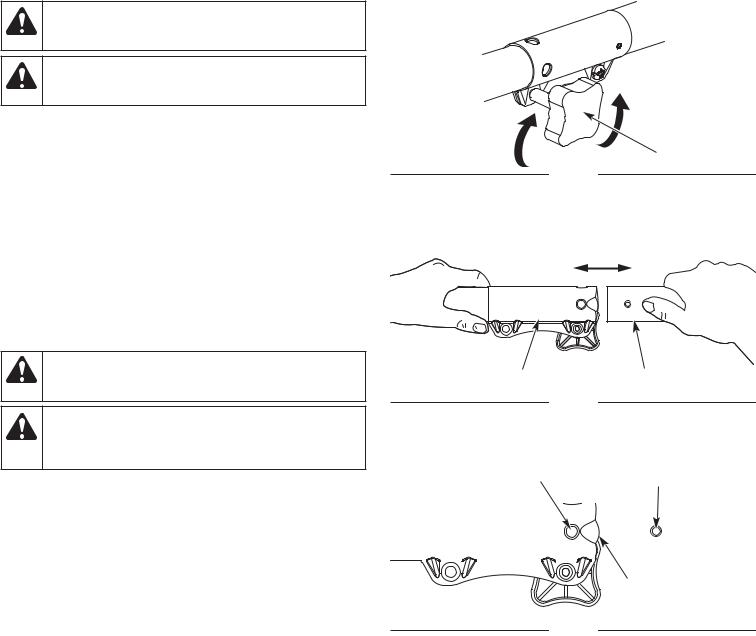
WARNING: Before using any attachment, read and understand the manual that came with the attachment. Follow all safety information contained within.
WARNING: To avoid serious personal injury and damage to the unit, shut the unit off before removing or installing an attachment.
OPERATING THE COUPLER
The coupler enables the use of various optional attachments.
Installing the Attachment
1.Remove the cap from the attachment. If present, remove the gray spacer from the coupler.
2.Set the unit on a flat, level surface.
3.Turn the knob counterclockwise to loosen the coupler (Fig. 4).
4.Align the release button with the guide recess (Fig. 6).
5.Push the attachment straight into the coupler (Fig. 5) until the release button snaps firmly into the primary hole (Fig.6).
6.Turn the knob clockwise to tighten the coupler (Fig. 4).
CAUTION: Before operating the unit, make sure the release button is fully snapped into the primary hole and the knob is securely tightened.
CAUTION: Unless specified otherwise, the release button should be snapped into the primary hole only. Using the wrong hole could lead to personal injury or damage to the unit.
Removing the Attachment
1.Set the unit on a flat, level surface.
2.Turn the knob counterclockwise to loosen the coupler (Fig. 4).
3.Press and hold the release button (Fig. 6).
4.Pull the attachment straight out of the coupler (Fig. 5).
7
Loosen
Tighten
Knob
Fig. 4
Coupler |
Attachment |
Fig. 5
|
|
|
|
Primary Hole |
|
|
|
Release Button |
|||||
|
|
|
|
|
|
|
|
|
|
|
|
|
|
|
|
|
|
|
|
|
|
|
|
|
|
|
|
|
|
|
|
|
|
|
|
|
|
|
|
|
|
|
|
|
|
|
|
|
|
|
|
|
|
|
|
Guide Recess
Fig. 6

OIL AND FUEL
OIL AND FUEL MIXING INSTRUCTIONS
The use of old and/or improperly mixed fuel is the most common cause of performance problems. Use only fresh, clean unleaded gasoline. Follow the instructions carefully for the proper gasoline/oil mixture.
Definition of Blended Fuels
Today's fuels are often a blend of gasoline and oxygenates such as ethanol, methanol or MTBE (ether). Alcohol-blended fuel absorbs water. As little as 1% water in the fuel can make fuel and oil separate, forming acids when stored. ALWAYS use fresh fuel (less than 30 days old).
NOTE: Dispose of old fuel according to federal, state and local regulations.
Using Blended Fuels
If using a blended fuel:
•Always use the fresh fuel mix explained in your operator's manual
•Use the fuel additive STA-BIL® or an equivalent
•Always agitate the fuel mix before fueling the unit
•Drain the tank and run the engine dry before storing the unit
WARNING: DO NOT USE E85 FUEL IN THIS UNIT. It has been proven that fuel containing greater than 10% ethanol will likely damage this engine and void the warranty.
Using Fuel Additives
The bottle of 2-cycle oil provided with this unit contains a fuel additive to help inhibit corrosion and minimize gum deposits. Always use the brand of 2-cycle oil that came with this unit. If this is unavailable, use a 2-cycle oil designed for air-cooled engines and mix it with a fuel additive, such as STA-BIL Fuel Stabilizer or an equivalent. Add 0.8 oz. (23 ml) of fuel additive per gallon of fuel, according to the instructions on the container. NEVER add fuel additives directly to the unit's fuel tank.
Mixing the Fuel
NOTE: This unit comes with a 3.2 oz. (95 ml) bottle of 2-cycle oil. To obtain the correct fuel mixture described below, pour the entire bottle into one gallon of unleaded gasoline.
CAUTION: For proper engine operation and maximum reliability, pay strict attention to the gasoline and oil mixing instructions on the 2-cycle oil bottle. Using improperly mixed fuel can severely damage the engine.
Thoroughly mix the proper ratio of unleaded gasoline with 2-cycle engine oil. Do not mix them directly in the unit’s fuel tank. Use a separate fuel can. Use a 40:1 gasoline/oil ratio. See the table below for specific gasoline and oil mixing ratios.
FUELING THE UNIT
WARNING: Gasoline is extremely flammable. Ignited vapors may explode. Always stop the engine and allow it to cool before filling the fuel tank. Do not smoke while filling the tank. Keep sparks and open flames at a distance from the area.
WARNING: Remove the fuel cap slowly to avoid injury from fuel spray. Never operate the unit without the fuel cap securely in place.
WARNING: Add fuel in a clean, well ventilated outdoor area. Wipe up any spilled fuel immediately. Avoid creating a source of ignition for spilled fuel. Do not start the engine until fuel vapors dissipate.
1.Position the unit with the fuel cap facing up.
2.Remove the fuel cap.
3.Place the fuel container spout into the fill hole on the fuel tank and fill the tank.
NOTE: Do not overfill the tank.
4.Wipe up any fuel that may have spilled.
5.Reinstall the fuel cap.
6.Move the unit at least 30 ft. (9.1 m) from the fuel container and the fueling site before starting the engine.
|
|
|
|
|
|
|
|
|
|
|
|
|
|
|
|
Unleaded gasoline |
2-cycle oil |
||
|
|
|
|
1 gallon U.S. |
3.2 fl. oz. |
||
|
(3.8 liters) |
(95 ml) |
|
|
|
|
|
|
1 liter |
25 ml |
|
|
|
|
|
MIXING RATIO - 40:1
8
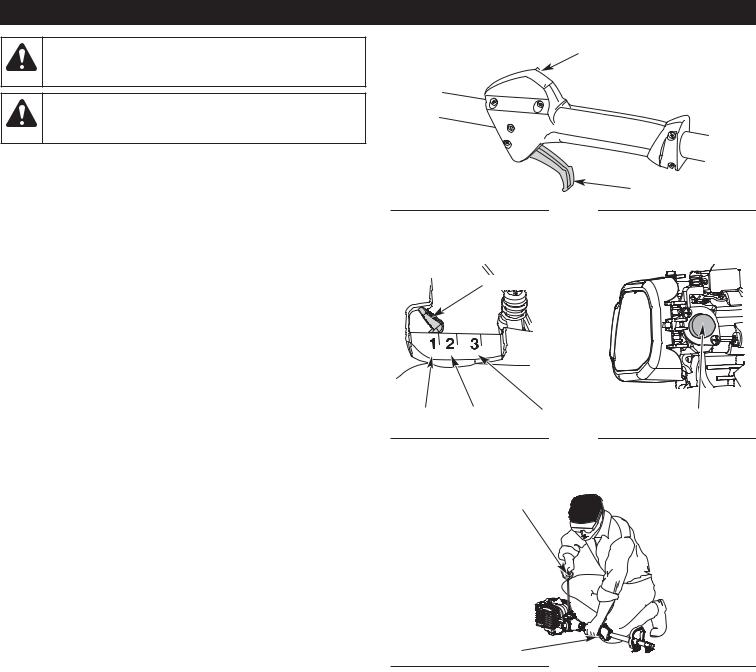
STARTING AND STOPPING
WARNING: Operate this unit only in a well-ventilated outdoor area. Carbon monoxide exhaust fumes can be lethal in a confined area.
WARNING: Avoid accidentally starting the unit. To avoid serious injury, the operator and the unit must be in a stable position when pulling the starter rope (Fig. 9).
STARTING INSTRUCTIONS
1.Mix gasoline with oil. Refer to Oil and Fuel Mixing Instructions.
2.Fill the fuel tank. Refer to Fueling the Unit.
NOTE: There is no need to turn the unit on. The On/Off switch is in the ON ( I ) position at all times (Fig. 7).
3.Slowly press and release the primer bulb 10 times (Fig. 8). If fuel cannot be seen in the primer bulb, press and release the primer bulb until fuel is visible.
4.Move the choke lever to Position 1 (Fig. 8).
5.Crouch in the starting position (Fig. 9).
NOTE: SQUEEZE and HOLD the throttle control for ALL further steps.
6.Squeeze the throttle control (Fig. 7) and pull the starter rope with a controlled and steady motion 5 times (Fig. 9).
7.Continue to squeeze the throttle control. Move the choke lever to Position 2 (Fig. 8).
8.Continue to squeeze the throttle control. Pull the starter rope with a controlled and steady motion 3 to 5 times to start the engine.
9.Continue to squeeze the throttle control. Allow the engine to warm up for 30 to 60 seconds.
10.Continue to squeeze the throttle control. Move the choke lever to Position 3 (Fig. 8) and continue warming the engine for an additional 60 seconds. The unit may be used during this time.
NOTE: The engine is properly warmed up when it accelerates without hesitation.
IF... the engine hesitates, return the choke lever to Position 2 (Fig. 8) and continue the warm-up.
IF... the engine does not start, begin the starting procedure with step 3.
IF... the engine fails to start after a few attempts, move the choke lever to Position 3 and squeeze the throttle control. Pull the starter rope with a controlled and steady motion 3 to 8 times. The engine should start. If it does not, repeat this instruction.
IF... the engine is already warm, begin the starting procedure with step 7.
STOPPING INSTRUCTIONS
1.Release the throttle control and allow the engine to idle.
2.Press and hold the On/Off switch in the OFF (O) position until the engine comes to a complete stop (Fig. 7).
Off (O) / Stop



 On ( I ) / Start
On ( I ) / Start
Throttle Control
Fig. 7
Choke Lever
Position 1 |
Position 2 |
Position 3 |
Primer Bulb |
|
|
Fig. 8 |
|
Starter Rope Grip |
|
Starting |
|
|
|
|
|
|
|
|
Position |
Throttle Control
Fig. 9
9
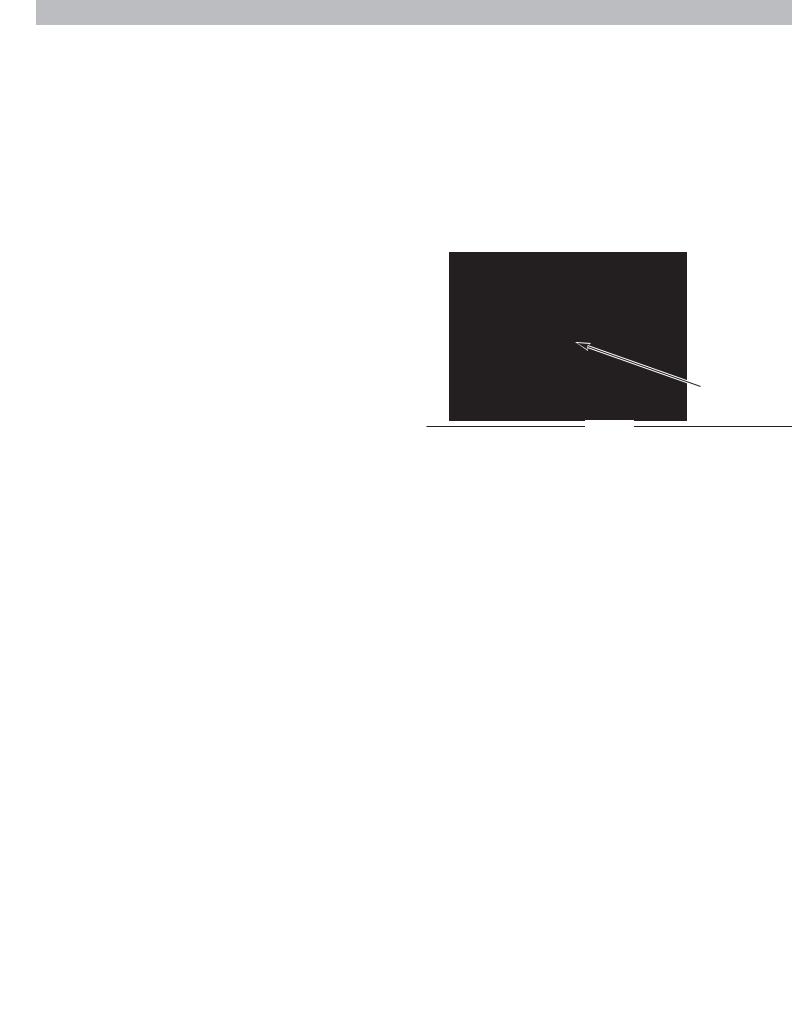
USING THE ELECTRIC START ACCESSORY
This unit can be started with an optional electric start accessory (items sold separately). Refer to the electric start accessory operator’s manual for the proper use of this feature.
Please contact your local retailer, call the Customer Support Department or visit our website for more information.
STARTING INSTRUCTIONS
1.Mix gasoline with oil. Refer to Oil and Fuel Mixing Instructions.
2.Fill the fuel tank. Refer to Fueling the Unit.
NOTE: There is no need to turn the unit on. The On/Off switch is in the ON ( I ) position at all times (Fig. 7).
3.Slowly press and release the primer bulb 10 times (Fig. 8). If fuel cannot be seen in the primer bulb, press and release the primer bulb until fuel is visible.
4.Move the choke lever to Position 1 (Fig. 8).
5.Crouch in the starting position (Fig. 9).
6.Insert the electric start accessory into the electric start port (Fig. 10). Refer to the Operation section of the electric start accessory operator’s manual.
NOTE: SQUEEZE and HOLD the throttle control for ALL further steps.
7.Squeeze and hold the throttle control (Fig. 7). Run the electric start accessory for 2 seconds.
8.Continue to squeeze the throttle control. Move the choke lever to Position 2 (Fig. 8).
9.Continue to squeeze the throttle control. Run the electric start accessory in intervals no longer than 2 seconds each until the unit starts.
10.Remove the electric start accessory from the unit.
11.Continue to squeeze the throttle control. Allow the engine to warm up for 30 to 60 seconds.
12.Continue to squeeze the throttle control. Move the choke lever to Position 3 (Fig. 8) and continue warming the engine for an additional 60 seconds. The unit may be used during this time.
NOTE: The engine is properly warmed up when it accelerates without hesitation.
IF... the engine hesitates, return the choke lever to Position 2 (Fig. 8) and continue the warm-up.
IF... the engine does not start, begin the starting procedure with step 3.
IF... the engine fails to start after a few attempts, move the choke lever to Position 3 and squeeze the throttle control. Run the electric start accessory in intervals no longer than 2 seconds each until the unit starts. The engine should start. If it does not, repeat this instruction.
IF... the engine is already warm, begin the starting procedure with step 8.
STOPPING INSTRUCTIONS
1.Release the throttle control and allow the engine to idle.
2.Press and hold the On/Off switch in the OFF (O) position until the engine comes to a complete stop (Fig. 7).
Item No. |
Description |
49M2027P966 . . . . . . . . . . . . . . . . . . . . . . . . . . . . . . .Electric Starter 49MESCBP966 . . . . . . . . . . . . . . . . . . . . . . . . . . . .Engine Starter Bit 49MRBESY966 . . . . . . . . . . . . . . . . . . . . . .Cordless Electric Starter
Electric Start
Port
Fig. 10
10
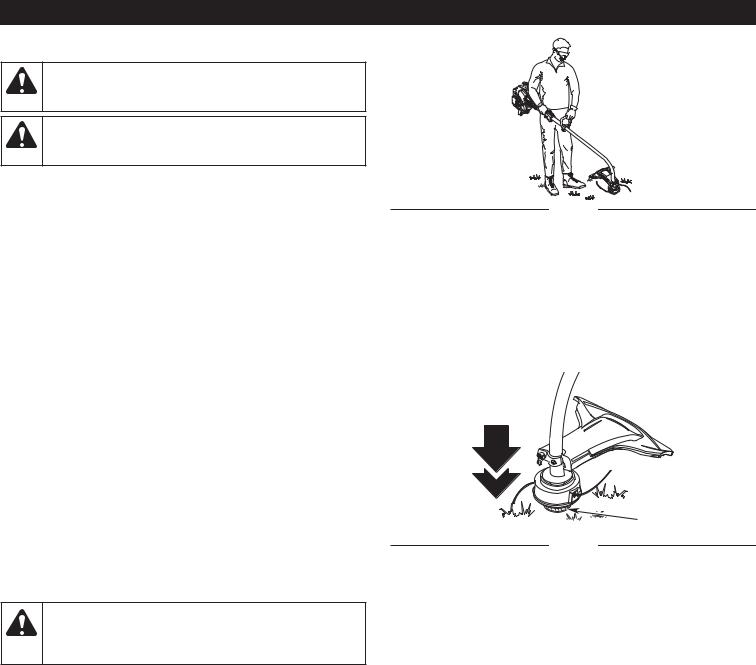
OPERATION
HOLDING THE UNIT
WARNING: Always wear eye, hearing, hand, foot and body protection to reduce the risk of injury when operating this unit.
WARNING: To prevent serious personal injury, avoid arm contact with the engine while operating the unit. The engine may be extremely hot.
• Stand in the operating position (Fig. 11). Stand up straight. Do not bend over.
•Keep feet apart and firmly planted.
•Hold the shaft grip with the right hand. Keep the right arm slightly bent.
•Hold the handle with the left hand. Keep the left arm straight.
•Hold the unit at waist level.
•Position the cutting head a few inches above the ground.
ADJUSTING THE TRIMMING LINE LENGTH
This unit is equipped with a bump head. Trimming line can be released from the cutting head without stopping the engine.
To release more line, lightly tap the bump knob on the ground (Fig. 12) while operating the unit at high speed. For best results, tap the bump knob on bare ground or hard soil. Attempting to release line in tall grass may stall the engine.
NOTE: Do not rest the cutting head on the ground while the unit is running.
Each time the bump knob is tapped, about 1 inch (25.4 mm) of trimming line is released.
NOTE: Always keep the trimming line fully extended. Line release becomes more difficult when the cutting line gets shorter.
A blade in the cutting head shield will cut the line to the proper length if any excess line is released.
CAUTION: Do not remove or alter the line cutting blade assembly. Excessive line length will make the unit overheat. This may lead to serious personal injury or damage to the unit.
TIPS FOR BEST RESULTS
•To direct clippings away from the operator, tilt the cutting head slightly down to the left; cut from right to left whenever possible.
•Do not trim wet grass or weeds.
NOTE: Some line breakage will occur from:
•Entanglement with foreign matter
•Normal line fatigue
•Attempting to cut thick vegetation
•Forcing the line into objects such as walls or fence posts
Fig. 11
Bump Knob
Fig. 12
11
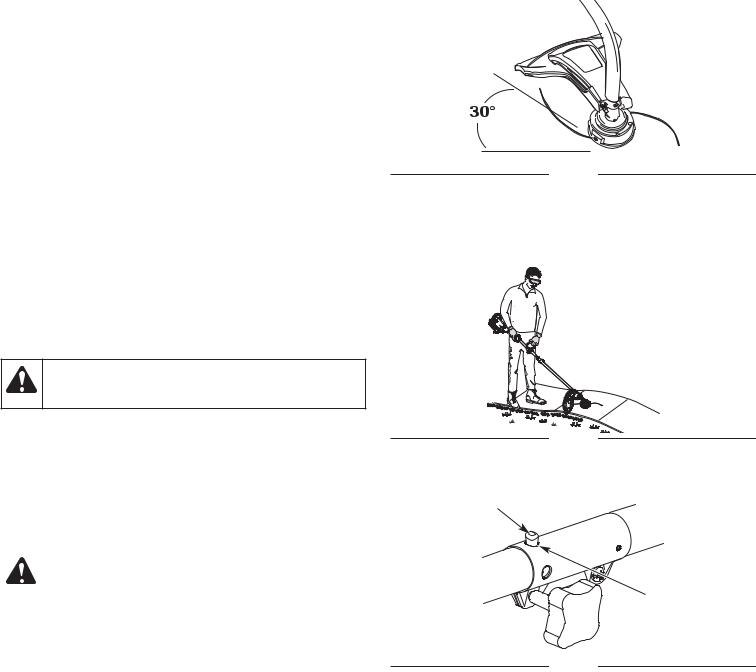
DECORATIVE TRIMMING
When trimming around trees, posts, fences, etc., rotate the whole unit so that the cutting head is at a 30° angle to the ground (Fig. 13).
Fig. 13
EDGING
The trimmer attachment can be used for edging (Fig. 14). Alternatively, bladed lawn edger attachments can also be purchased for use with this unit.
Rotating the Trimmer Attachment
WARNING: To avoid serious personal injury and damage to the unit, shut the unit off before rotating the attachment.
When edging around sidewalks, flowerbeds, etc., rotate the trimmer |
Fig. 14 |
attachment 90° inside the coupler. DO NOT rotate the entire unit 90°. |
1.Turn the knob counterclockwise to loosen the coupler (Fig. 4). Refer to Operating the Coupler in the Assembly section.
2.Press and hold the release button (Fig. 6).
3. |
Rotate the attachment until the release button snaps firmly into |
Release Button |
|
|
the 90° edging hole (Fig. 15). |
|
|
4. |
Turn the knob clockwise to tighten the coupler (Fig. 4). |
|
|
|
|
|
|
|
|
CAUTION: Only snap the release button into the 90° |
|
|
|
edging hole when edging with the trimmer attachment. |
|
|
|
Using the 90° edging hole with other attachments could |
|
|
|
lead to personal injury or damage to the unit. |
|
|
|
|
|
Maintaining the Trimming Line |
|
Hard surfaces, such as sidewalks, can cause the trimming line to |
|
wear down quickly or break. |
Fig. 15 |
•Frequently check and adjust the trimming line length. Refer to
Adjusting the Trimming Line Length. Always keep the trimming line fully extended.
•DO NOT force the unit. Make shallow cuts in as many passes as are necessary to achieve the desired depth. Cut at a slow, even pace.
90˚ Edging Hole
12
